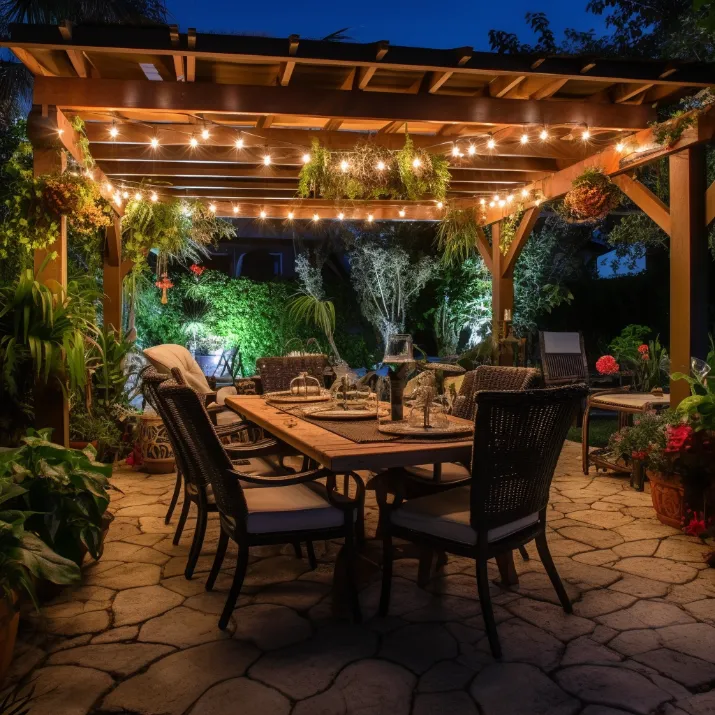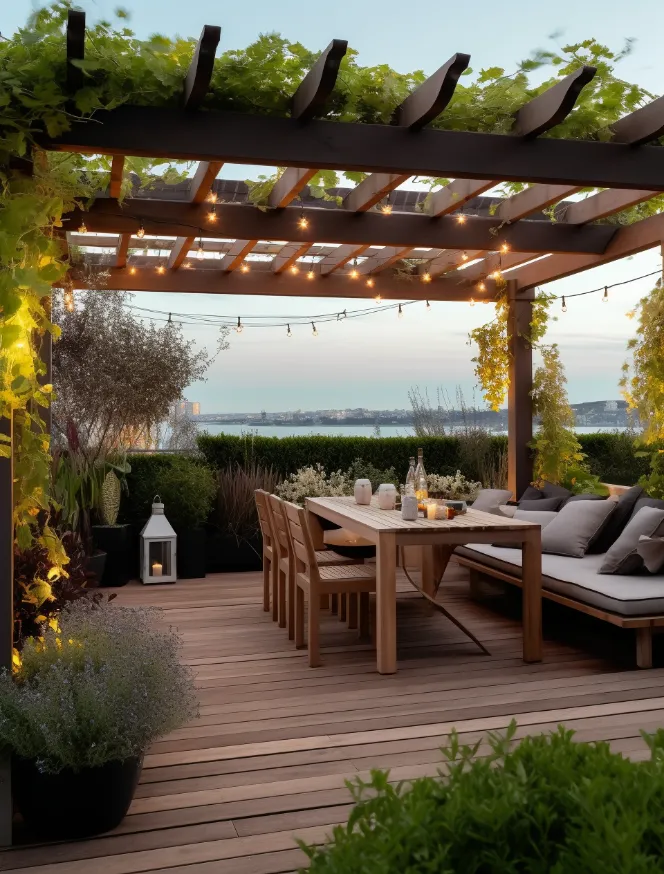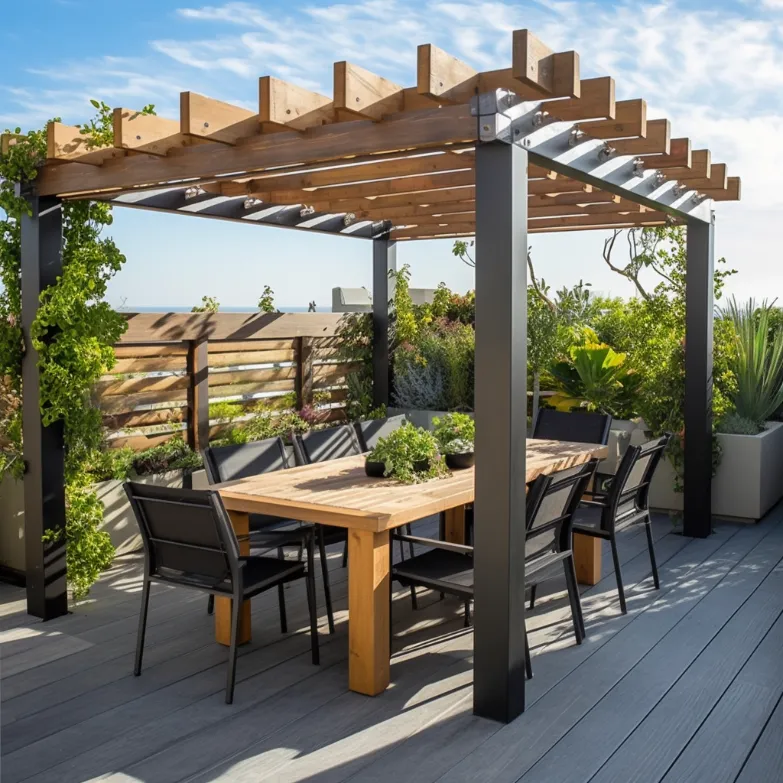Introduction
When venturing into the realm of constructing a wood pergola, numerous crucial aspects must be taken into account. These factors are vital for the durability and effectiveness of your outdoor edifice. Comprehending your pergola, including the selection of appropriate timber, is key. Additionally, ongoing upkeep is indispensable for its prolonged existence and visual charm.
In this guide, we’ll explore the complexities of wooden pergolas. We’ll examine various wood types and their suitability. Furthermore, we’ll discuss cleaning and inspection routines. Seasonal care is another crucial element, as is preventing pests. Techniques for staining and sealing will also be covered. Additionally, we’ll look at ways to integrate greenery, enhancing your pergola’s allure. Finally, we will consider safety measures. These steps are essential to maintain the allure and functionality of your outdoor sanctuary.
Understand Your Wood Pergola
Embarking on your wood pergola journey requires understanding. It’s crucial to know your pergola well. First, consider the wood selection. This choice significantly influences your pergola’s longevity and visual appeal. For instance, Cedar is renowned for its natural resilience. It effectively combats decay and pests. On the other hand, Redwood and pressure-treated pine bring distinct qualities. They cater to your needs for durability and aesthetics. Furthermore, it’s essential to remember maintenance. Activities like staining and sealing are imperative. They preserve your pergola’s beauty. This maintenance varies, depending on wood type and climate conditions. With wooden pergolas, design possibilities are limitless. They allow you to create a unique outdoor sanctuary, customized to your tastes. Wooden pergolas, often preferred over aluminum, offer adaptability and rustic allure. It’s important to carefully choose the right wood. This decision shapes your pergola’s durability and style.
To explore further, let’s delve into the common wood types for pergolas. Western Red Cedar is notable for its resistance and captivating reddish tint. It’s also easy to work with. Redwood emerges as another superior choice. It’s celebrated for its stability and elegance. Conversely, pressure-treated pine is an economical alternative. Meanwhile, tropical hardwoods like Ipe and Mahogany promise luxury and endurance. European Green Oak offers a classic, sturdy option. These woods differ in cost, appearance, and maintenance. This variety enables customization to your budget and style preferences. Identifying your pergola’s wood involves several steps. These include examining visual aspects, checking the finish, and consulting the builder or seller. Online resources and wood experts are valuable aids in this endeavor. Lastly, don’t forget environmental factors. Elements like moisture, sun exposure, wind, and insects significantly affect your pergola’s lifespan. Regular maintenance and protection are vital in combating these challenges.

Regular Cleaning and Inspection
Maintaining your wood pergola in top-notch condition necessitates a regimen of consistent cleaning and detailed inspections. These actions are vital for its durability and visual charm.
Cleaning the Wood Surface
- Initially, prepare a cleansing mixture. Blend water with mild dish soap or opt for a wood cleaner to tackle tougher dirt.
- Employ a soft bristle brush for gentle scrubbing. This process eliminates debris, grime, and persistent stains.
- It’s critical to shun abrasive materials and harsh chemicals. They can mar the wood’s innate allure.
Tools and Materials Needed
- Water: Utilized as the primary element for cleansing mixtures and rinsing purposes.
- Mild Dish Soap: Perfect for creating a non-aggressive cleaning solution.
- Soft Bristle Brush: Guarantees an effective clean without damaging the wood.
- Ladder: Essential for accessing elevated or difficult areas.
- Wire Brush: Proves efficient for stubborn stains.
- Old Toothbrush or Magic Eraser: Ideal for detailed or hard-to-reach spots.
- Biodegradable Outdoor Cleaner: Beneficial for ingrained dirt or mildew.
- Safety Equipment: Includes safety goggles and protective clothing, particularly if staining or sealing post-cleaning.
Step-by-Step Cleaning Process
- Begin by removing debris, such as leaves and soil.
- Rinse the wood surface with a hose. This step helps eliminate loose dirt and preps for intensive cleaning.
- If needed, concoct a solution of mild soap and water for deeper cleansing. In certain scenarios, a bleach mixture might be apt. Ensure comprehensive rinsing afterward.
- Post-cleaning, rinse the wood thoroughly. Use clean water to wash away any soap or cleansing agents. A hose or pressure washer can be advantageous.
- Let the pergola air dry fully before embarking on maintenance tasks like staining or sealing.
- Optionally, apply a premium protective coating, stain, or sealant. This step aids in shielding the wood from environmental elements.
Inspecting for Damage
- Regular inspections are indispensable for early problem identification and damage prevention.
- Visual inspection should encompass the entire structure. Focus on detecting structural issues like cracks, sagging, or warping.
- Stability checks are crucial to confirm the pergola’s security and stability.
- Be vigilant about examining beams, rafters, and supporting posts. Look for cracks, warping, or signs of wear and tear.
- Routine inspections are an effective method to promptly identify and resolve issues.
Common Issues to Look For
- Structural challenges such as cracks, splits, or wood warping.
- Wood selection is crucial; even rot-resistant varieties like cedar or redwood may succumb to decay or insect harm.
- Water-related problems like warping, mold, or mildew are detrimental to wood.
- Sun exposure can cause fading. Counter this with UV-protective sealants or finishes.
- Be alert for insect damage signs like tiny holes, sawdust, or weakened wood.
- Regular upkeep, including cleansing and resealing, is key to maintaining the wood’s integrity.
Signs of Wear and Tear
- Structural instability, indicated by leaning or sagging components.
- Look for visible cracks, warping, or twisting in beams and support posts.
- Notice fading or discoloration due to elemental exposure.
- Inspect for tears or significant damage in fabric coverings, if applicable.
- Check for gaps or damage in timber board connections.
- Observe any rust or corrosion on metal fasteners or brackets.
- Be aware of pest damage or wood-boring insects that could weaken the structure.
Consistent cleaning and inspections, coupled with prompt issue resolution, are essential. They ensure your wood pergola remains beautiful and functional for years. A bit of care significantly extends the life of this outdoor feature.

Seasonal Maintenance
Preparing for Winter
- Treating and Sealing the Wood: Start by treating and sealing the wood to ensure resilience in winter. Select a suitable outdoor wood stain and sealant for your pergola’s specific wood type. This protective layer will shield against the cold, moisture, and other winter elements. Consequently, it extends the pergola’s lifespan.
- Covering or Protecting Your Wood Pergola: It’s wise to provide extra protection for your wood pergola during winter. Initially, conduct a thorough cleaning to eliminate dirt and mold. You might want to employ shade-generating materials, such as fabric canopies or retractable awnings. Alternatively, natural vines and greenery can be effective. For added creativity, consider outdoor curtains or bamboo shades. Some homeowners opt for temporary plastic or fabric covers as an additional barrier. Conducting regular inspections throughout winter ensures your pergola remains in prime condition, preparing it for the upcoming seasons.
Spring Revitalization
- Sanding and Refinishing: With spring’s arrival, it’s time to rejuvenate your wood pergola. Begin by removing any accumulated dirt and grime. Depending on the wood’s state, you may choose to refinish, restoring its original look, or stain it for enhancement and protection. Sanding is essential for a smooth, uniform surface, ensuring optimal appearance.
- Addressing Any Structural Issues: Maintaining a robust and safe pergola is crucial throughout the year. Regular checks enable you to identify any damage indicators, like cracked wood, loose connections, or structural frailties. Act swiftly to resolve these concerns. Replace damaged components, bolster weak joints, and execute necessary repairs. Alongside consistent maintenance, such as cleaning and resealing, your wood pergola will continue to be a beautiful, functional outdoor asset.
By adhering to these seasonal maintenance routines, your wood pergola will stay resilient, appealing, and useful across the varying seasons.

Preventing Pest Infestations
Identify Common Wood Pests
- Termites are sly invaders. They often remain hidden, only revealing themselves after causing significant damage.
- Powderpost beetles are another threat. They leave behind minuscule holes and powdery frass.
- Wood borers are a concern too. They deposit eggs in wood, thereby weakening its structure.
- Lyctid beetles, including southern and western varieties, have a preference for starchy wood.
- Regular inspections are crucial. They aid in early detection of these pests.
Preventative Measures to Protect Your Wood Pergola
- Surround your pergola with pest-repelling plants like citronella and marigolds.
- It’s advisable to keep wood elevated off the ground. This strategy deters pests and prevents decay.
- Before priming and painting, apply borate. This substance acts as a termite repellent.
- Staining and sealing your wood pergola is beneficial. It offers moisture and insect protection.
- Consider installing screens or netting. They are effective in keeping bugs away.
- Employ landscaping techniques. Utilize bug-repelling plants and natural sprays.
- Routine maintenance should include staining and sealing. This creates a protective barrier.
- Periodic inspections are vital. They help identify problems before they worsen.
How to Deal with an Infestation If It Occurs
- Accurate pest identification is paramount. It ensures effective control.
- Regular inspections are necessary. Look for damage, nests, or pest trails.
- Good ventilation is essential in maintaining wood. It helps prevent infestations.
- For mildew, clean wood with mild soap and water. Add a mild bleach solution.
- Replace corroded fasteners when needed. This restores the wood’s integrity.
- In cases of severe or uncertain infestations, seek professional assistance.
By adhering to these guidelines, you can safeguard your wood pergola from pests. This ensures its longevity and structural soundness. Identifying common wood pests, executing preventative strategies, and promptly addressing infestations are imperative. They maintain the allure of your outdoor area.

Staining and Sealing
Benefits of Staining and Sealing
- Enhanced Durability: Staining prolongs your pergola’s lifespan. It shields against weather and pests. This is crucial for longevity.
- Weather Resistance: A protective barrier forms against moisture and UV rays. It also resists fading effectively. This ensures resilience.
- Aesthetic Appeal: Staining elevates the wood’s natural allure. You can choose from various color options. This enhances visual appeal.
- Ease of Maintenance: Maintenance becomes simpler. Your pergola remains easier to clean and upkeep. This is beneficial for upkeep.
- Cost Savings: The process prevents early deterioration. Consequently, it saves you money over time. This is economically advantageous.
- Increased Property Value: It significantly boosts curb appeal. Your home’s value increases as a result. This is an investment in your property.
Choosing the Right Stain and Sealant
- Wood Selection: Choose sturdy woods like cedar or pine. They’re known for their durability. This choice is foundational.
- Stain Color: Opt for clear or colored stains. Match them with your outdoor aesthetics. This step personalizes the look.
- Sealant Choice: Select a clear sealant. It preserves beauty and prolongs wood life. This is a protective measure.
- Wood Preparation: Ensure the wood surface is smooth. Sand and clean thoroughly. This prepares the wood for treatment.
- Proper Application: Adhere to manufacturer’s guidelines. Use the right brushes and sprayers. This ensures effective application.
Step-by-Step Application Process
- Material Preparation: Gather all necessary supplies. Don’t forget safety gear. Preparation is key.
- Pergola Cleaning: First, remove any accessories. Then sweep and clean with a mild detergent. This is the initial step.
- Sanding: Smooth out any imperfections. Ensure the surface is ready for absorption. Sanding is essential for this.
- Stain Application: Apply the stain in even, thin coats. Always go in the direction of the grain. This technique is crucial.
- Sealing: Protect the wood from moisture and UV rays. Use a quality sealant. This step ensures protection.
- Drying Time: Allow adequate time for drying. Follow the instructions carefully. Patience is necessary here.
- Accessory Reassembly: Reattach any previously removed items. This marks the completion of the process.
- Maintenance: Regularly monitor your pergola. Reapply sealant as needed. Ongoing care is essential.
Staining and sealing your wood pergola not only boosts its beauty but also strengthens it against the elements. It adds value to your property while reducing future repair costs. Select the appropriate products and meticulously follow the application steps. This ensures a lasting and attractive outdoor structure.

Plants and Vines on Your Wood Pergola
Benefits of Adding Greenery
- Enhanced Aesthetics: Introducing plants and vines to your wood pergola adds natural allure. It transforms the outdoor area into a visually captivating space.
- Shade and Comfort: The foliage offers natural shade. Consequently, your pergola becomes a cool retreat, ideal for sweltering summer days.
- Privacy Oasis: The plants serve as an organic screen. They provide a secluded, intimate atmosphere within your pergola.
- Eco-Friendly Touch: These botanical companions purify the air. In doing so, they foster a healthier backyard environment.
- Property Value Boost: A lush, well-designed pergola elevates your home’s value. It creates an attractive outdoor living area.
- Vertical Garden: Training climbing plants on your pergola forms a mesmerizing vertical garden. This feature adds an extraordinary layer to your space.
- Defined Spaces: Plants help distinguish specific zones within the outdoor setting. This approach renders the pergola both more functional and appealing.
Selecting Suitable Plants
- Climbing Elegance: Choose climbers like rambling roses. They elegantly drape over your pergola, offering beauty and fragrance.
- Climate Consideration: Pick plants that adapt to your local climate. Different species flourish in varied conditions.
- Low-Maintenance: Opt for easy-care plants. This choice streamlines maintenance for your pergola garden.
- Aesthetic Harmony: Select plant hues and shapes that blend with your pergola’s design and your style.
- Fragrant Choices: Consider aromatic climbers such as jasmine. They infuse your pergola with a delightful fragrance.
- Plan and Research: Investigate your plants’ needs and growth habits. Plan their placement for optimal sunlight, water, and support.
Maintaining Plant Health Without Harming the Wood Pergola
- Trim and Tend: Consistently prune and maintain climbing plants. This practice prevents overgrowth and damage to the wood.
- Yearly Cleaning: Use a high-pressure hose annually to remove dirt and debris. This step preserves the wood’s condition.
- Stain and Seal: Apply stain and sealant to protect the wood. This method safeguards against moisture, UV rays, and pests while supporting plant health.
- Mildew Management: If mildew or stains develop, use appropriate cleaners. This keeps the wood pristine and extends your pergola’s life.
- Debris Removal: Regularly eliminate fallen leaves and branches from the roof and beams. This action prevents accumulation that could harm both plants and wood.
By adopting these practices, you’ll relish the splendor of your greenery and your wood pergola’s functionality. Simultaneously, you ensure the wellbeing of the plants and the longevity of the pergola.

Safety Considerations For Your Wood Pergola
Ensuring Structural Integrity
To ensure structural integrity, it’s crucial to perform regular inspections. We must diligently search for signs of wear, damage, or insect infestations. Promptly addressing these issues is essential to maintain structural strength. Additionally, applying protective sealants and stains is vital. These coatings prevent moisture absorption, thus preserving the pergola’s integrity. It’s advisable to reapply these treatments every few years for long-term effectiveness. Proper installation is also key. Secure anchoring and the use of treated timber, in compliance with building codes, ensures stability and safety. Regarding fire safety, especially when using a fire pit, it’s imperative to use fire-resistant roofing. Maintaining a safe distance is also crucial to prevent potential hazards. Lastly, routine maintenance is necessary. This includes regular cleaning, applying protective coatings, and using high-quality materials to sustain both appearance and durability. Following a comprehensive maintenance plan guarantees that your pergola remains strong and reliable for many years.
Checking for Loose or Damaged Components
Regular inspections are crucial in identifying early signs of wear and tear. This proactive approach helps in averting the escalation of any issues. Stability and safety are paramount. Thus, tightening any loose screws or fasteners is essential to ensure the pergola is secure and stable. A thorough visual inspection is also necessary. Be on the lookout for cracks, sagging, rotting timber, leaning posts, peeling paint, sun damage, and insect infestations. Moisture and decay are formidable enemies of structural integrity. Therefore, addressing decaying or rotting wood without delay is critical. Additionally, replacing or repairing any rusted or splintered parts is vital to maintain the overall integrity of your pergola.
Safety Tips for Maintaining Your Wood Pergola
Maintaining your pergola requires regular cleaning. This process removes debris that could potentially cause damage. Applying a high-quality, wood-specific protective coating is also essential. This coating shields the pergola from weather elements and UV rays. Additionally, it’s crucial to periodically seal and re-stain treated wood. This process not only maintains the color but also protects the wood from moisture and sunlight. For optimal results, use translucent, oil-based wood stains that are suitable for your wood type. By adhering to these safety considerations and maintenance tips, you’ll be able to enjoy the beauty and safety of your wood pergola for many years.

Maintaining the Beauty of Your Wood Pergola Sum Up
- Regular Cleaning: Maintain your pergola’s cleanliness by scrubbing it gently. Use a soft brush, alongside mild soap and water.
- Protective Coating: Enhance its durability with a top-notch wood protector. This step shields it from harsh weather conditions.
- Regular Inspections: Consistently inspect for any looseness, cracks, or rot. Promptly rectify these issues to ensure longevity.
- Stain or Waterproofing: You might want to add a stain or waterproofing. This additional step offers extra safeguarding.
- Trim Vegetation: Regularly prune overgrown vines and plants. This action averts potential structural harm.
- Seasonal Inspection: At each season’s onset, carry out extensive examinations. Look for any damage or pests.

Conclusion
To conclude, a wood pergola is an enchanting enhancement to your outdoor area. It provides shade, style, and a touch of nature. To preserve its allure and structural soundness, you need both knowledge and consistent upkeep. Firstly, choose the appropriate timber. Additionally, carry out periodic inspections. Furthermore, adhere to seasonal maintenance practices. It’s also vital to ward off pests. Equally important is the application of protective treatments. By incorporating foliage, you elevate its charm. Consequently, your wood pergola will continue to be a magnificent and durable aspect of your outdoor sanctuary. These diligent efforts will lead to prolonged periods of delight and tranquility beneath your exquisitely preserved wood pergola.

